LEARNING ABOUT THE FINNISH SPITZ
On this page I am planning to collect various articles - translated or my own - about the Finnish Spitz. I hope you will enjoy and learn more about our national breed. Maybe the first article should be about the history of the breed.
We all know that Hugo Rickhard Sandberg was the first promoter of the Finnish Barking Bird Dog. He was also a keen and active advocator of sports. He was particularily interested in skiing as sports. At the same time as he announced the rescue of the native spitz dog he wrote a book about skiing called "Skiing as Sports in Finland". Naturally on the cover there is pictured a young hunter with a spitz dog. The facts and photos of this article are from various books completed with my own impressions of those times. When pointing on the photo of any dog you can read who he/she is.
EXCERPTS FROM THE HISTORY OF THE FINNISH BARKING BIRD DOG
Before the Finnish Kennel Club (Suomen Kennel Klubi, SKK) took the responsibility to keep the studbook records, the ”Sporten” magazine (a Swedish-language magazine) collected records from the first known specimens of the breed already in 1890. They did not use any “numbers” for them and the dogs were identified only by name/owner and sometimes parents or the place where they came from. Not all these dogs received the studbook numbers or gained the breed status.
The first Finnish Kennel Club Show was held on 23 rd -25 th of May 1891 in Helsinki. That event gave prizes to five dogs – four males and one female. The second show, which was also called an International Show, was held the next year on 13 th -15 th of May 1892 also in Helsinki. This time there were classes for males, females, pups and litters. The enthusiasm was big and a Specialty Show was held on the same year of 1892 on 16 th -17 th of December, this time in Oulu – North Finland, a total of 93 dogs were shown, but the jury of five gentlemen was not impressed. Only 14 were awarded. In those first events dogs of “various quality” were introduced as Finnish Barking Bird Dogs, but we can only find 17 males and females that actually were taken to the studbook at that time.
The Finnish Kennel Club Studbook was opened in 1892 and rightly so the Finnish Barking Bird Dogs received the first numbers in alphabetical order – males first and females second. All of the dogs included in the registry had been shown and awarded.
Mostly the dogs were reddish, but there were also a few grey or even black dogs taken to the studbook. And many of them had white on chest and legs, some up to the elbows – and of course a white tail tip. Hugo Richard Sandberg writes in his article of the Finnish Bird Dog (Sporten 15.12.1890): “When barking the dog is a little way from the tree wagging his tail, which usually has a white tail tip, and which together with the reddish colour of the dog interests the bird very much.” He also writes the first description – standard you could say – of the dog already then. There he writes about the colour: “The best colour for the bird dog is yellowish red or reddish brown, which colours are usual in several places. There are also black, wolfgrey and grey specimens. The belly and under side of the tail is usually a little lighter and the tail tip is generally white.”
The first standard was verified already before the SKK's second show on 24 th of March 1892. There the darker colours are not favored. “The colour is fox red. Belly and under side of the tail are a little lighter, tail tip usually white, white chest and white feet are not considered a fault, black, wolfgrey and other colours are not preferred.”
The first dogs were of course of various conformations too. From the documents one can find that Sandberg, also called “Big-Sandberg/Iso-Samperi” as he was nearly 2 meters (6ft 8inc) tall, had probably seen good specimens that had a longish body and maybe he himself preferred them. That type was called “foxy”. One of the first registered “Rehvi 7”, had a longish body and so did “Kiltti”. Of course females are a bit longer in body than males. There was some discussion about the body length during the first years, some were in favor of the longer and some in favor for the shorter body.
Whom can we “blame” or “thank” for the fact that the shorter coupled type won, when the standard was revised in 1897? That must have been the younger of the Hugos – Hugo Jonathan Roos. He had seen good dogs on peasant Penna Tampio's farm 1892, and they were short coupled. Roos had bought his first dog in 1890, “Pilkka” who was mated to “Virkku”. He kept a female called “Hilli”, but he sold it afterwards. There are no pics of these available. He waited two years to get a dog from Penna Tampio. The pup was born in January of 1894 and was named “Halli of Tampio 690”. He was a prototype of a short-coupled type. Roos was very fond of Halli, and it is only human to think that what I like best must be the best. Maybe Halli was the reason why he preferred the shorter body type. The photo shows clearly that Halli was not a very well angulated dog either, he was robust and deep chested. His colour was quite light - reddish yellow, but we cannot distinguish from the photo how much white he had. But he seems to have had a white tail tip. He also had dewclaws on his back legs. But he was a good hunting dog and sired some good pups too. 
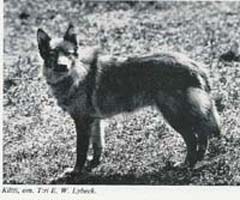
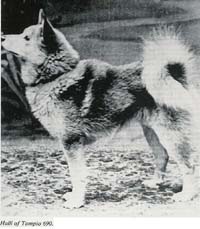
Besides Halli, Roos had bought a good bitch from Kuusamo named “Aili 952” which was born in 1892. There are no records concerning how many times Aili was used in her early youth, but the most influental breeding took place in 1905. Some doubt from my behalf is Aili's age at that time – 13 yrs – is it really possible that this was the same dog Roos had found and, which was born in 1892? Or could there have been a youger Aili – perhaps her daughter, and the records have ignored that fact?
In December of 1904 (Oulu Dog Show) Roos had seen Kaarlo Castren's “Veikko 951” (also known as Weikko, born probably 1901 and Lappi's 704/VI full brother), who was Halli of Tampio's greatgrandson and he was fascinated with his bright red colour. Roos mated his Aili with Veikko and chose two pups: “Lalli Veikonpoika 1307” and “Alli Veikontytär 1309” for future breeding. Both Veikko and Aili had white on chest and feet, Aili had even a white muzzle and the pups Lalli and Alli were coloured as their parents. The unfortunate thing was that Veikko had cow hocks, and he passed that fault to his progeny.
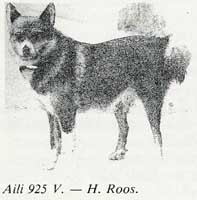
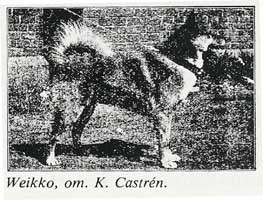
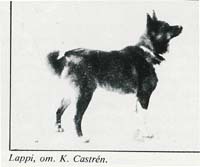
Because available dogs for breeding were few, that unfortunate fact was just what one had to live with. Roos's next step was that he mated “Ola 943”, who was out of “Hupsu 691” and “Kilmu 955” (Halli of Tampio's daughter) with Alli Veikontytär and Siiri of Tampio 7/VIII was born. Siiri was then bred with Lalli Veikonpoika and the pups had a COI of 13% contributed by Aili, Veikko and Halli of Tampio. Thus Roos became the first breeder who used inbreeding to accomplish faster results. Hugo Roos can be called the first influental breeder of the Finnish Barking Bird Dog. His breedings made a core of todays breed that we call the Finnish Spitz.


The problem of the breed was the hindquarters. It is written in various comments from shows that many of them had weak and/or thin back legs. Strange comment in one of the early show reports was: “The back legs are weak and too much bent at the knee”. Why was the straighter knee preferred to the more bent one? As I see it – it could have been because of horses. The stifle of the horse is not very prominent and it is situated quite high up as the horse has a short thighbone (femur) and a longer shinbone (fibula/tibia) and most men at that time were used to seeing horses, so they compared the horse conformation to the dog conformation. The big struggle toward straight knees, as the standard of 1897 says: “Legs in proportion to the body, mid length, strong and straight, stifle straight, dense and longhaired on back of thighs”, nearly ruined the dog. Curious thing is that the 1925 standard does not mention legs or feet at all! Already in 1937 it was obvious that breeding for straight legs had gone too far. S.E. Multamäki, a known breeder (Hammon-kennel) and judge uses his wordly whip and writes: ”Somehow we have gone forward. We have accomplished some refinement, but the “tools” have worsened. Look at the back legs of our dogs. They have become like sticks or canes, the hockjoints are simply unsound, also with those dogs that have been awarded.”
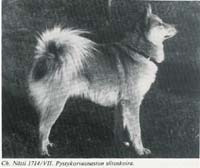
Let us return to the early years of 1900s. Veikko unfortunately had cow hocks. To correct this fault Hugo Roos mated “Nätti 1714/VII” – a stud dog bought by the Finnish Kennel Club's Spitz Division – and “Alli Veikontytär” in 1911, to correct the back legs and tail set. This was a successful breeding at it was repeated next year. One of the progeny from this mating is “Siekki Lallinpoika 324 VIII (00324/0X)”, who is behind many of todays Finnish Spitz, maybe most of them. “Nätti 1714/VII” was born on 24 th of March 1906, he was also light red – but as one can see from the photo, he wasn't very well angulated either. He stands with his legs under him, but one can assume that he was not cow hocked.He seems to have quite long and flat coat. In some aspects he resembles Halli of Tampio. Nätti had a very good tail set, so all these could have been the reasons why Roos liked him. It could not have been Nätti's bird hunting merits – he had not shown very good results in that respect – as he had a passion to hunt squirrels. The Spitz Division had placed Nätti first to Haapamäki, then to Nabbas, and so forth. As his owners – or keepers – had not cared so much of the dog – he did not know what was expected of him. In 1912 Nätti changed owners again. Now he at last – at the age of 6yrs – found someone who cared for him. The new and fifth owner was Antti Tanttu. He taught Nätti away from barking squirrels and he became a very good hunting dog in his later years. Nätti was also shown and he was the first Finnish Spitz ever to gain Championship in 1914.
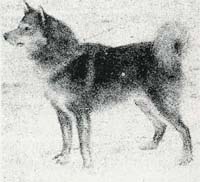
Next time we will look into the history of hunting trials.
Sources:
-Suomenpystykorva 100 vuotta - Tiististä kansalliskoiraksi (Finnish Spitz 100 years) - Suomenpystykorvajärjestö/Finnish Spitz Club
-Suomenpystykorva - Yrjö Ritvola